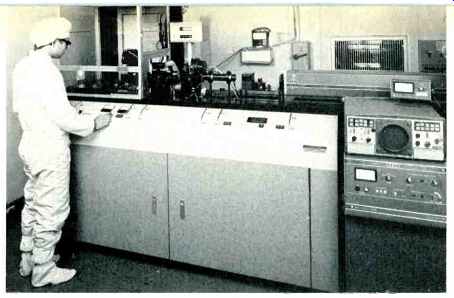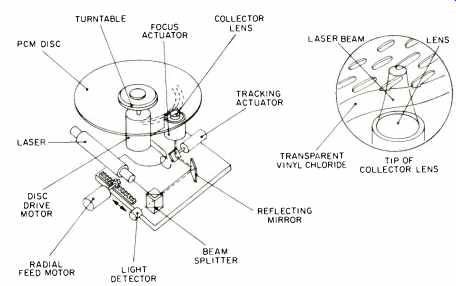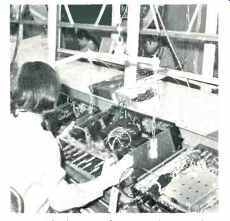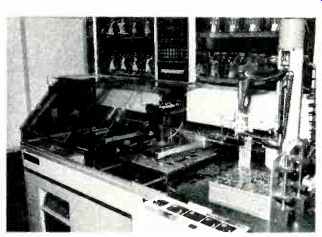The Japanese "Audio '77" Show was held in the Harumi exhibition complex situated on the edge of Tokyo Bay where two hangar-type halls were occupied by more than 80 exhibitors, including several from the U.S. and Europe. The seven-day show attracted more than 200,000 enthusiasts who crowded into the demonstration rooms and booths to examine and tinker with the equipment on display. Unlike shows in the U.S. where "do not touch" signs discourage knob twiddlers, visitors to "Audio '77" were actually asked to use the equipment and participate in the various recording sessions. Companies such as Sansui, Optonica, Akai, and Yamaha had well-equipped studios in which the audience was invited to tape programs given by performers, and then keep the tape they had made. Some of these sessions were quite involved, and the performance might be preceded by talks on mike placement, mixing, reverb, and so on. Headphones were used for monitoring and playback, while the recorders were mostly cassette models.
Many new cassette decks were shown and, I'm sure, many of them will be released in the U.S. for the Winter CES in Chicago. However, there were two or three models which were particularly interesting. One was the Pioneer CT-700 which features variable bias, in addition to three meters ... the third one indicating either the bias voltage or L & R dynamic levels. Sony introduced the Model TC-K8B which uses a very effective liquid crystal display for VU calibration in the form of horizontal green bars moving along a calibrated scale. A touch of the switch would freeze a small segment at the tip to give a maximum reading, much like a thermometer. The response is very fast and visibility excellent, so I'm certain that other companies will soon take up the idea. Sony also showed two new Elcaset decks, the EL-4 and the EL-D8 ... the former is a less expensive version of the EL-7, while the latter is a portable model expected to sell in the U.S. for around $600.00. Hitachi also had a new Elcaset deck that is marketed in Japan by Hitachi's high-end company, called Lo-D. JVC was demonstrating a new model using a series of LEDs in place of the VU meters, and each LED responds to a particular frequency band.
In the high price bracket, the majority of new models featured variable bias, monitoring, logic controls with displays, and most had provisions for timers and FM Dolby. Front-loading cassette decks outnumber other designs by about three to one, and the present trend is towards black styling, although some manufacturers are offering a choice of either black or silver.
There were a great number of new turntables at the show, especially direct drive models in all price ranges.
I had a number of discussions with engineers and marketing managers at the various manufacturing plants, and the general opinion was that the belt drive design gives better performance in the least expensive models than the direct-drive units. Naturally, there was some dissent on this point, but all seemed to agree that the quartz-controlled, direct-drive models represented the state-of the-art performance at the present time. As far as the S-shaped tonearm controversy is concerned, there is unanimous agreement that other parameters such as cartridge compliance, choice of bearings, mass, and so on are far more important.
Two new TEAC models, the A-3300 and the A-2300, were shown; each has an automatic reverse facility and they have an SR suffix. A new model, the F1, is a half-track machine with 3 3/4 and 7 1/2 ips speeds. Divided into two units with the electronics section underneath, it has a built-in test tone generator, variable bias and equalizer controls, plus separate equalizing for playback. The digital counter is in the form of a display calibrated in minutes and seconds, while the tape transport system is controlled by logic circuitry via feather-touch buttons. A dbx adaptor is an optional accessory on both units.
Akai also introduced a dual-unit recorder, but this one has only one speed, 3 3/4 ips. Nevertheless, the frequency response is claimed to be within ± 1 dB from 50 Hz to 20 kHz.
Loudspeakers
For me, the most interesting item at all audio shows, no matter where held, is loudspeakers. And so it was in Tokyo, there were a number of exotic models to be seen and heard. In general, there seemed to be two trends . . one towards the "linear phase" designs and the other towards the large horn-loaded systems. Sanyo was demonstrating several examples of linear phase speakers and the leaflets carried the usual explanations of "time delays" and "coherent sound." One model, a three-way system, has a 2 1/2 in. midrange dome, a 3/4, in. tweeter, and a 10-in. woofer mounted so it projected out about two inches. All the diaphragms are made from metal with the woofer cone fabricated from porous metal.
A similar semi-staircase configuration is used in the three new Sony systems, the largest having a 15 in. bass driver which crosses over to a 4-in. cone at 550 Hz, and a 1 1/2-in. dome tweeter at 4.5 kHz. This has a titanium diaphragm and works as a pressure unit with equalizer fins. I observed that care had been taken in the enclosure design in respect to dissimilar resonances for the side and back.
The Technics range of linear phase systems is well known here, but they were also showing a large floor standing system using horn-loaded midrange and treble speakers. The system uses a 15-in. woofer and the two horns stand on top with the midrange projecting slightly from the front of the cabinet, which is curved to match the mouth of the horn.
Classified as Japanese model number SB-1000, the speakers sell for over $2000.00 each, which is an astronomical amount of yen! The Onkyo Sceptre 500 is another large floor standing system in the same rarified price range, but the tweeter is mounted along with the midrange horn outside on the top of the unit. The tweeter is fitted with a multi-plate diffuser, and a small super tweeter extends the range at the high end.
Another system using the external horn is the largest model in Pioneer's Excellence range. In this model, the 15 in. bass driver is horn loaded from the front, and the treble unit has a diffuser similar to the one used in the Technics model. Both NEC and Coral were also showing large systems using the horn loading bass drivers.

----- Making a PCM master disc at the TEAC facility.

------- The laser sound disc player.
Pulse Code Modulation
One of the sensations of the show was the appearance of several PCM (pulse code modulation) systems. Sony has employed a digital recording system for their Betamax Video player, and Denon has been making PCM recordings for a long time ... but both of these systems use tape, not records.
However, Denon makes records from the tapes after the signals are converted back into audio, thus losing most of the advantages. A consortium of three companies, TEAC, Mitsubishi, and Denka, have now developed a PCM record which has so many potential advantages that it will make our present system of recording obsolete.
Imagine a record with a dynamic range 30 to 40 dB greater than our present discs with no wow, no flutter, no background noise, pops, crackles, or scratches. It sounds too good to be true, but it must be admitted that at the present time there are snags like the high cost and the restricted playing time. However, these problems will be solved in time.
The master disc is made of glass having a thin film of gold alloy deposited on it, and laser records the digital signal in the form of a continuous line of holes, called "pits." This track width is extremely small, being only about 1/100th the size of the conventional record groove. The stamper is then made from the master in the usual manner, and the final discs are made from a transparent PVC material, plated with a metallic surface and then covered by a protective coating.
The playback system is made up of a turntable rotating at 1800 rpm, a laser with the associated optics, a servo system, plus the PCM amplifier. The laser is mounted under the disc. Note that there are four servo systems: the quartz locked motor drive, the focusing servo that maintains a constant distance between the disc surface and the collecting lens, the tracking servo keeping the readout beam directly over the "pits," and, lastly, the radial feed system that moves the laser beam optics in the radial direction.
After amplification, the digital pulses are converted back into audio signals. The dynamic range of this system is more than 98 dB, with a frequency response of 10 Hz to 20 kHz, +0.1 dB,-0.5 dB and the total THD is claimed to be less than 0.1 percent.
The disc itself has a diameter of 12 inches with a thickness of 1/24th inch.
Playing time is only 30 minutes, but I was told that development work is going on to increase this to one, or even, two hours. How did the laser disc actually sound? It was all I had expected, velvety quiet background with a tremendous dynamic range ... rather like 30-ips tape with a Dolby "A" system.
There are several other PCM systems in various stages of development which could pose a standardization problem. Fortunately those responsible are well aware of what happened with quadraphonic sound with CD 4, QS, and SQ. As mentioned earlier, Sony uses a PCM system in their Betamax Video Player, but now they have developed a separate unit which permits PCM recording and playback which can be connected to any VTR system. The audio (analog) signals are converted into digital pulses, which in turn are converted into video signals that can be recorded. The theoretical range is 97.8 dB, but it stated that due to the problems of cost, a compromise was necessary and the range is held to 95 dB for playback and 85 dB in the recording mode.
The Denon PCM system has some similarities with the Sony system, but the sampling frequency is 47.25 kHz, instead of 41.25 kHz, and a two-inch tape is used. The dynamic range is improved by a pre-emphasis circuit ... the final figure being 89 dB with less than 0.1 percent THD and immeasurable wow and flutter. Denon (the parent company is Nippon Columbia) has been making PCM tapes for some years now, and now they have a library of well over 200. Their records show a worthwhile improvement over ordinary discs in the S/N ratio. Further information may be obtained from their American distributors, American Audioport, 1407 N. Providence Rd., Columbia, MO 65201.

--- Assembly line at the Sansui operation showing the lifting cradle.
Plant Tours
A number of manufacturers invited me to visit their production and research facilities. I was pleased to have the opportunity to study the different philosophies and methods of doing things, and then compare them with our Western ideas. Although the Japanese society is highly industrialized, the people as a whole, not just the elite, have a high regard for art and culture. The TV programs devote considerable time to art appreciation, and in the theater ... both the traditional and modern are very much alive.
At the Kenwood plant, I noticed a number of girls coming back after the production lines had shut down. I enquired whether there was a second shift. As it turned out, these girls were going to flower arrangement lessons (Ikebana) which, as most people know, is a special Japanese art.
At the Pioneer facility, I was surprised to find a complete recording studio with a Quad Eight mixing unit, Neumann lathe cutter, a separate mix down room, and several listening rooms. Recently, a number of direct recordings have been made which have been, mainly, for demonstration purposes although some are marketed under the name "Lobster." A large studio is used for loudspeaker evaluations and provision is made for feeding signals directly from the recording studio, or vice versa.
Most Japanese houses are furnished in the traditional style with a minimum of furniture and the floors are covered with special rush mats called tatami.
These rooms are often quite small and the acoustics are rather different from Western style rooms, so all the plants I visited had both Western and tatami listening rooms.
The Nakamichi plant now boasts a small theater and during the Audio '77 show period, groups of 50 to 100 people were invited to listen to a piano or harpsichord recital. Tapes were recorded on an impressive-looking bank of Nakamichi 600 cassette decks, and tapes were given out to the audience at the end of each recital. At the session I attended, the program consisted of piano works by Brahms, Schumann, and Chopin. The harpsichord was a beautifully-made reproduction of an 18th century French instrument finished in an orange lacquer with a decorated lid.
Behind the theater is a control room, a mixing room, and a large recording studio -- and, of course, there are several Western and tatami style listening rooms.
Sansui's plant was notable for the clever way in which the maximum amount of space is utilized in the production area. Conveyor belts operate on three levels, just like the Tokyo expressway. This particular plant on the outskirts of Tokyo turns out nearly 500 amplifiers and receivers a day, with a total of 350 employees.
The next day I visited the Sony research facility and audio development labs, which are all housed in one large building completed in 1972. Here I found not one, but two anechoic chambers--the larger one with a cubic volume of 528 meters. It extends through three ordinary stories and the structure floats independently from the main building. Next to it is a reverberation room with a 10-second period, and nearby are a number of Western and tatami listening rooms.
There is also a very large auditorium and a special room for "psycho acoustical experiments" which has to do with four-channel sound, not rock music.

----- Operation of the automatic printed board assembly line at the Technics
plant.
The following evening, I was invited to the home of Masura Nagami, the Sony General Manager, to listen to his super audio installation. The speakers featured four 12-in. bass drivers, coupled to a pair of horns extending about 10 feet above the listening area, with the mouths being some four feet square. At 220 Hz the signals are handled by a horn-loaded midrange unit built into the wall, and at 1 kHz a smaller horn driver takes over. High frequencies are handled by a small pressure unit working from 5 kHz up.
Each speaker has its own amplifier (class A or V-FET), which is preceded by an electronic crossover, and a Sony preamp (incidentally Nagami was the designer of the famous Sony 2000F preamp). The phono cartridge was their new moving-coil model, the XL55 (one of the best cartridges I have yet tested), and it was connected to a low noise HS-55 head amplifier. As you might expect, the reproduction was most impressive, especially at the low end.
Other trips took me to the Yamaha facility at Hamamatsu and the Technics plant in Osaka. At both places much time was spent in discussions with the engineers about future products, design trends, and so on. I was particularly impressed with the automation on the Technics production lines. Specially designed machines inserted components onto the boards, soldered them, and then passed them onto an automatic alignment machine. Banks of trimming tools came down and made the adjustments, while colored lights and readouts indicated faults. Joints that were not dip soldered were individually soldered by irons that moved upwards and downwards like robots. Final tests were carried out by technicians in soundproof rooms, and the test equipment was designed so that faults could be located almost immediately. Overall quality control was very thorough.
Trade has to be two way, and there is a considerable market for certain American-made audio products in Japan. Both JBL and BSR had booths at Audio '77. In the British contingent, Celestion, Quad, and five other manufacturers were represented there.
Many other companies had representatives there and all reported that business was good.
Another potential Asian market will be the Republic of China (Taiwan). Already the second most prosperous country in Asia, it is presently going through a period of tremendous construction and expansion.
(Source: Audio magazine, Feb. 1978, George W. Tillett)
= = = =